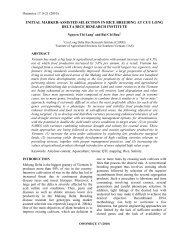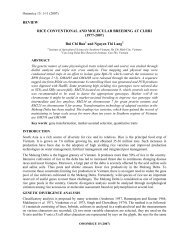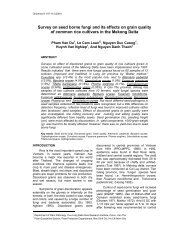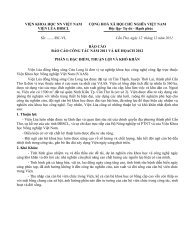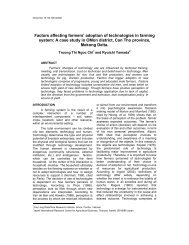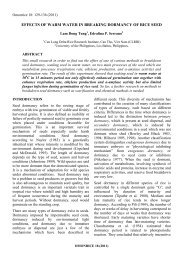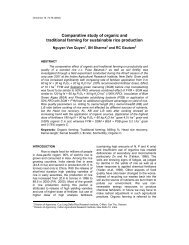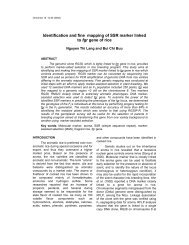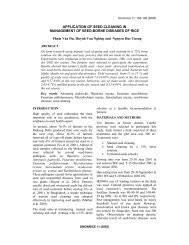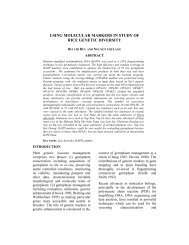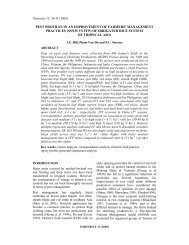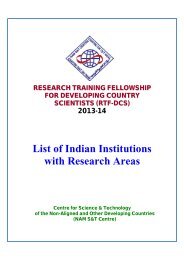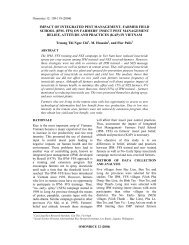EXPLOITATION OF Beauveria bassiana AND Metarhizium ...
EXPLOITATION OF Beauveria bassiana AND Metarhizium ...
EXPLOITATION OF Beauveria bassiana AND Metarhizium ...
Create successful ePaper yourself
Turn your PDF publications into a flip-book with our unique Google optimized e-Paper software.
Exploitation of <strong>Beauveria</strong> <strong>bassiana</strong> and <strong>Metarhizium</strong> anisopliae ...<br />
153<br />
studied and applied to manage various insect pests<br />
on many crops around the world (Rombach et al.<br />
1986a and b; Aguda et al. 1987, 1988;<br />
Ramamohan Rao 1989; Butt and Copping 2000;<br />
Goettel et al. 2000; Nugroho and Ibrahim 2007<br />
and Yubak et al. 2008.<br />
In Vietnam, <strong>Metarhizium</strong> anisopliae and<br />
<strong>Beauveria</strong> <strong>bassiana</strong> have been studied and applied<br />
in controlling of rice Brown planthoppers, rice<br />
bug, coconut beetle, grasshoppers, termite etc.<br />
(Chinh et al. 2001; Thuy et al. 2001; Loc 1995,<br />
1997a and b; Loc et al. 1999, 2001, 2002, 2004,<br />
2005).<br />
Citrus are main fruit in agriculture production in<br />
the Mekong Delta. The Citrus pyrilla (Diaphorina<br />
citri) is a most serious sucking insect pest of<br />
citrus-tree in the world as well as in Vietnam. It is<br />
a vector transferring Liberobacter asiaticum<br />
bacterium causes greening disease, the main<br />
damage of citrus-tree group. The Black citrus<br />
aphid (Toxoptera sp.) is also an important pest<br />
sucking the sap of the citrus young shoots and<br />
leading deformation of citrus shoot. Thereafter,<br />
leaves are twisted, stunted and no fully<br />
development is expected. Black citrus aphid is a<br />
vector to transfer the “Tristeza” disease of citrus.<br />
The farmers in Cuu Long delta who are cultivating<br />
citrus-tree group always spray insecticides every<br />
15 days to control these two serious sucking<br />
insects.<br />
The microclimate occurred in the citrus gardens<br />
would be quite suitable for the fungal disease<br />
development and moreover the cadaver of insect is<br />
followed by external sporulation which helps<br />
fungus to be spread in very high levels to kill<br />
insects. Unlike bacteria or virus, fungi penetrate<br />
actively and do not require ingestion to infect,<br />
thus, the fungi have a better prospect in the<br />
microbial control of sucking insect pests of citrus.<br />
Therefore, the project “Exploitation of <strong>Beauveria</strong><br />
<strong>bassiana</strong> and <strong>Metarhizium</strong> anisopliae as potential<br />
biocontrol agents in integrated pest management<br />
(IPM) on citrus” was conducted. The specific<br />
objective of this study deals with isolating the<br />
<strong>Beauveria</strong> <strong>bassiana</strong> (B.b) and <strong>Metarhizium</strong><br />
anisopliae (M.a) from naturally infected insects to<br />
select those having high insecticidal activity<br />
against target insects of citrus. The formulation<br />
will target two serious sucking insect pests of<br />
black citrus aphid, Toxoptera citricidus and citrus<br />
pyrilla, Diaphorina citri and eventually it will be<br />
incorporated into IPM program of citrus in the<br />
Mekong Delta of Vietnam.<br />
MATERIALS <strong>AND</strong> METHODS:<br />
1.1. Collection, isolation and purification the<br />
entomogenous fungi (B. <strong>bassiana</strong> and M.<br />
anisopliae):<br />
The fungal infected insects, soil samples were<br />
collected from different locations of Can Tho and<br />
Vinh Long, particularly at some gardens where the<br />
farmers were less applying the pesticides<br />
regularly. The insects were found to be sticking to<br />
the leaves of citrus, and overgrown by chalky<br />
white or green mass of conidia. The cadavers were<br />
collected in sterile glass tube for isolating the<br />
causal organisms in the laboratory. The fungus<br />
culture was purified by single conidium culture on<br />
potato dextrose agar (PDA) medium and<br />
subsequently subculturing was done as Loc<br />
(1995).<br />
1.2. Inoculation and identification:<br />
The pure fungal culture was multiplied on PDA<br />
medium for 10 days. Conidial concentration was<br />
adjusted to 10 7 conidia ml -1 in suspension and was<br />
applied directly on the insects in plastic jars.<br />
Control insects were sprayed with 0.02 percent<br />
Tween 80 ® solution instead of conidia suspension.<br />
Thirty insects were retained on each citrus shoot in<br />
a plastic jar and covered with muslin cloth. There<br />
were 4 replications. The mortality was recorded<br />
after 5 days and the death insects were collected<br />
and incubated in BOD incubator for 3-4 days and<br />
examined under microscope (Rombach et al.,<br />
1986a)<br />
The fungus was reisolated from infected insect and<br />
single conidium culture was purified and<br />
compared with original isolate. The single<br />
conidium culture was identified for confirmation<br />
of the pathogen (Loc, 1995).<br />
1.3. The pathogenicity tests<br />
The pathogenicity tests with different isolates of B.<br />
<strong>bassiana</strong> and M. anisopliae against nymphs of<br />
black citrus aphids and citrus pyrilla were done in<br />
the same way as specified above (Rombach et al.,<br />
OMONRICE 17 (2010)



